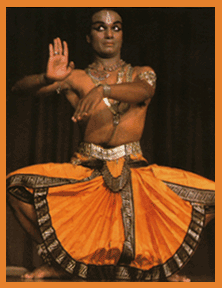Various Dances of India :
Dance and music are all-pervasive in India, bringing colour and sound to festivals and reaffirming the faith of the people in their heritage. Religion, philosophy and myth cannot be divorced from their art forms in India. Dance and music are tied inextricably to ceremony. Weddings, births, coronations, entering a new house or town, welcoming a guest, religious processions, harvest time are all occasions for music and dance, which in this country demand a spirit of devotion and total surrender. A sincere practice of the arts can achieve the highest spiritual experience.
Bharata Natyam | Kathakali | Odissi and Kathak |Manipuri |
Traditional Dance | |Kuchipudi |
Bharata Natyam is Tamil Nadu's most celebrated art form, a tradition that demands of the dancer a detachment from wordly ties, a sublimation of the self to the deity and her art. Such devadasis, "Servants of God", carried a temple tradition forward, until patronage shifted to the hands of the landed aristocracy who branded them prostitutes.
Bharat Natyam is a dynamic, earthy and extremely precise dance style. It is built upon a balanced distribution of body weight and firm positions of the lower limbs, allowing the hands to cut into a line and to flow around the body.
Kathakali :
Kathakali is the most developed dance drama art of India. In Kerala, the drums roll, beckoning an audience to a spectacle most magnificient. Here, the actors depict characters from the Puranas and Mahabharata - superhuman beings, demons and ordinary people.
The dancers, all male, adorn themselves in huge skirts and headdresses, wearing vivid green make-up and cheek extensions. Dialogue is combined with dance to bring myth and legend vividly to life in the temple courtyards of Kerala. So strong is the identification of the dancers with the characters they play that they display an incredible level of histrionic skill. Their eyes are riveting.
Odissi and Kathak :
The ambience of Orissa, the philosophy of Lord Jagannath and the sculpture of the 13th-century Sun Temple of Konarak, are reflected in the dance form - Odissi. Perhaps the most lyrical style of dance in India, Odissi follows unique body norms; the iconography of a whole culture is echoed in its structure. The tribhanga, a three-bend posture, interlinking a people's philosophy with the physical, is a series of triangles which are not only physically difficult to execute, but which also call for immense restraint and finesse on the part of the artist.
The Kathak (storyteller) of yore was a versatile actor-musician-dancer who addressed himself directly to his audience, throwing a web of verse and verve over them. Involved and complicated footwork and rapid pirouettes are the dominant and most endearing features of this style. Traditionally the dance of the courts, Kathak reflects a simplicity and vigour that is visually most attractive. Companies of dancing gypsies toured with Kathak dancers in the late 1990's to highlight similarities with Spanish flamenco.
Manipuri :
Protected for years in a valley of exceeding beauty, Manipuri is the art expression of every man, woman and child of Manipur. The musical forms of that culture reflect the worship of Vishnu. It is around episodes from his life that the faith of the people is entwined. Manipuri is not aggressive. It is tender and almost reticent on the one hand, and extremely vigorous on the other. A continuity of movement and a restraint of power are underlying features of the style.
Traditional Dance :
Indian dance forms take their themes from the Hindu pantheon and from a variety of folk legends. Vishnu, the Protector, in his 10 incarnations, is perhaps the most popular deity-depicted in classical Indian dance. His consort in Lakshmi, goddess of beauty and wealth. She reappears as Sita and Radha, consorts to two of his later incarnations. Rama, Vishnu's seventh incarnation, is celebrated, along with his consort Sita, in the epic Ramayana, a rich source of themes and anecdotes for presentation in Indian dance. Another popular incarnation is the colorful Krishna, beloved of Radha, and charioteer and counsellor to Arjuna.
Kuchipudi dance of Andhra Pradesh :
TOP
This site is designed and maintained by Taurus Infotek
